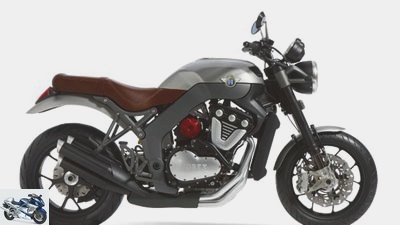Menus

Horex
Technology: Horex VR6 1200
The engine of the Horex VR6 1200
The developers open the next chapter in the Horex story: The engine collects its first operating hours on the test bench. MOTORRAD was there exclusively.
An illustrious group of top-class scientists and engineers crowd into the engine test bench. A prototype of the Horex VR6 engine is planted. Clemens Neese, the Horex boss, seems turned up. He’s about to press the start button and start the mighty six-cylinder.
S.or has been headed by Professor Dr.-Ing. Martin Doll started the Horex project at the university. He proudly shows the single-cylinder test engine on which the basic research for the design of the VR engine was carried out. "We pushed the cylinder further and further to the side in order to find out the maximum twist", he explains. "Set?" "The offset between the cylinder axes and the crankshaft axis". I see. One thing is clear: the Horex engine is a very special piece of German engineering. Similar to the VW VR engine, the cylinders are nested inside one another to save space, the pistons of the two cylinder banks run at an angle of 15 degrees to each other. However, the two cylinder axes meet below the crankshaft, which is why lateral forces that generate friction act on the pistons. With the single-cylinder test engine, the Munich-based company explored the sensible boundary between twisting and friction. The VR6 starts immediately and falls into an excited babble. What a sound! The six manifolds lead into a large collector under the gearbox and then into three mufflers with silencers, which should already correspond to the series status. Nevertheless, the VR speaks an extremely clear language even when idling.
Horex
A sectional model shows the nested arrangement of the combustion chambers and cylinders.
Amazing: the cylinder and head are finished cast parts, the engine is flanged to the test bench via the already installed gearbox and is measured in sixth gear. So Horex seems to be way further along with development than some previously thought.
Engine builder Rupert Baindl cautiously engages. The sound swells when you accelerate. Under full load, the mechanically powered loader begins to hiss brightly, you can literally feel the tremendous power of the 1200. Even at 2000 rpm, the engine puts considerable torque on the brake. The six-cylinder will later turn once up to 8500 rpm. "We can build in up to 240 hp", explains Clemens Neese. "For the first version, however, we will limit the output to a maximum of 200 hp."
That’s more than enough for a naked bike. how does the VR6 sound? Unlike the VW engines. A mixture of three-cylinder and V4, unique in each case. Horex drives an unusual firing order of 1-2-3-6-5-4. The engine turns up to 6000 rpm under full load, and the hair on the back of the neck stands up with a pleasant shiver. You can physically feel the tremendous torque of the Horex-VR6. Then the Munich test rig team lets it go. The VR6 sobs sadly down the speed ladder and is finally switched off by the Horex boss. "We have more power than expected, so we can lower the rated speed and gear the charger higher." Clemens Neese looks very satisfied. Everything is still going according to plan. So far there have been hardly any mechanical problems, the engine oil of the VR6 is carefully checked every few hours of operation.
A second engine is currently being set up for the test drives. And the production location will soon be announced. At the INTERMOT trade fair, the Horex stand was very crowded. The dream of the brand’s resurrection actually seems to be coming true.
Related articles
-
The technology of the new BMW K 1200 S engine
Drawing: BMW The technology of the new BMW K 1200 S engine Lateral thinker It is surprising that BMW installed the engine of the new K sideways according to the current pattern. But…
-
Test and technology: BMW R 1200 GS and its competitors
Alschner 36 pictures Schedl 1/36 KTM 1190 Adventure Manufacturer 2/36 Ducati Multistrada 1200: two-cylinder 90-degree V-engine, chain, power: 148 PS, …
-
Comparative test BMW K 1200 LT, Harley-Davidson Electra Glide Ultra Classic, Yamaha XVZ 13 TF Royal Star Venture Beautiful living Eating kilometers, for two, …
-
Endurance test Harley-Davidson Sportster 1200 Sport
Endurance test Harley-Davidson Sportster 1200 Sport sharpening iron Almost three years of the Harley-Davidson Sportster 1200 Sport – an unusually long endurance test era …
-
BMW R 1200 R, Honda CB 1000 R and MV Agusta Brutale 800 in a comparison test
Rivas 18 pictures Arturo Rivas 1/18 picture gallery: Comparison of middle class Nakeds. BMW R 1200 R, Honda CB 1000 R, MV Agusta Bruale 800. Arturo Rivas 2/18 …
-
Jahn 21 pictures Jahn 1/21 Once in motion, the respect for the imposing stature disappears in an instant. Because the Horex can be used for such a chunk …
-
Technology KTM LC8 engine Hot phase KTM is starting the hot test phase with the new two-cylinder V-engine. MOTORRAD was able to exclusively at …
-
BMW R 75-5 and BMW R 1200 R Classic
Gargolov 14 pictures Gargolov 1/14 Two BMWs in a generation comparison: R 1200 R Classic and R 75/5. Gargolov 2/14 BMW R 75/5 and R 1200 R Classic. Gargolov …
-
Driving report Yamaha XT 1200 ZE Super Tenere
Gargolov 26th photos Gargolov 1/26 Gargolov 2/26 Gargolov 3/26 Gargolov 4/26 Gargolov 5/26 Gargolov 6/26 Gargolov 7/26 Gargolov 8/26 Gargolov 9/26…
-
fact Top-Test BMW R 1200 S The new S Even the R 90 S and R 100 S tried to establish the S as the epitome of sport in the BMW range …